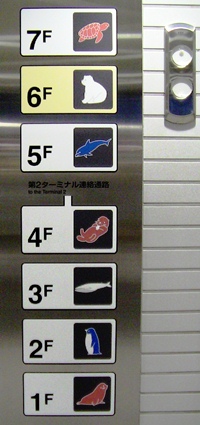I was leaving Haneda Airport in Tokyo, recently, when I ran across the following sight in the parking garage. This is a panel next to the elevator buttons.
 My first thought, I must admit, upon seeing the animal pictures next to the numbers for each floor was that it was taking the Japanese fondness for cute and cuddly a bit too far.
My first thought, I must admit, upon seeing the animal pictures next to the numbers for each floor was that it was taking the Japanese fondness for cute and cuddly a bit too far.
Yet upon reflection, I realized just how brilliant it was. I’m sure I’m not the only one who has found themselves in a parking garage trying to remember which floor I left my car on. Even worse, at the airport it’s often been several days since I left the car. My brain has probably processed dozens of floor, room, street, telephone and other numbers in that time. I’ve probably thought about a lot more numbers than I have polar bears, penguins or dolphins.
Written numbers are abstract concepts. The concept of using “4” to represent X, X, X and X may seem childishly simple, but as evolutionary advances go, it was a profoundly important development. As far as we can tell from prehistoric art and symbols, we’ve been doing it for less than 100,000 years.
Yet our prehistoric ancestors have had the ability to recognize and remember images, such as what other animals looked like, for millions of years. Their survival depended on it. Those ancient visual memory systems are far more robust and reliable than our rather recent and tenuous grasp of the abstract. That is why you are far more likely to forget someone’s telephone number than you are to forget what they look like.
Parking garage patrons are more likely to confuse 2 with 5 than they are to confuse penguins with dolphins, so to make it easier for them to remember their floor number, the designers gave them a more tangible association. They just have to remember that they parked on the penguin floor.
As a speaker, you can use this same technique to make your abstract concepts easier to remember.
You can use PowerPoint to associate images with your ideas. If you are selling computer network security, an image of a bank vault door will anchor the concept far better than a dozen bullet points of technical data can.
You can use a prop to make a metaphor concrete. If you are trying to motivate your staff after a bad quarter, a glass half filled with water and placed dramatically on the podium can anchor the metaphor that a glass half empty is also a glass half full, and drive home the point that they need to keep the bad news in perspective.
You can use an action, a sound, an image, an analogy, a story or an acronym to anchor your abstract concepts to something that is easier to understand and remember.
Take a tip from the designer of the elevator panel. Make it easier for your audience to recall what you’ve told them. Give them something tangible to associate with your concepts.







{ 1 comment… read it below or add one }
I SEE what you mean, R.L.
You nailed it. We think by associations and “seeing” things in our mind’s eye leaves impressions and makes connections that numbers can’t do.
Thanks for the Post!
{ 1 trackback }